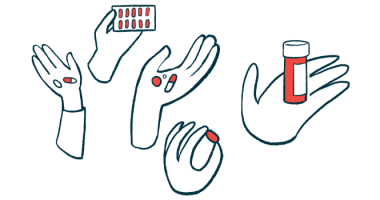I Push My Limitations by Setting Goals
by |

Come on! Is it essential to set goals in life? Do we need them? How can those of us who deal with a muscle-wasting illness push ourselves appropriately and live life to the fullest extent possible?
I can tell you that it’s easy to fall into inaction if we don’t find a motivation. We each have different ways of driving ourselves to accomplish something. We need to find our passion and use it to strive and thrive.
We often talk about setting goals in life that we can quantify at some level. I agree that putting things into a numerical representation helps me to recognize when I’ve achieved success. I tend to quantify everything. I also realize from years of working with individuals as a life coach and counselor that individual approaches to goal-setting vary widely.
If you’re a numerical person, I get you. Before I had symptoms of a type of muscular dystrophy called LGMD2L, a friend said to me that I “count everything.” And the comment wasn’t made with a tone of admiration. He may have been a little frustrated because he didn’t need to know how many points I’d scored in a pickup basketball game between friends. I have to admit that I overdid it a bit.
But this preference for numerical goals has led to some of my biggest successes. I’ve learned how to approach work and life efforts in other areas. I believe that setting a long-term goal and breaking it down into components is like driving with the headlights on. You know where you are, where you started from, and how far you still need to go. My Cuban-Lebanese grandmother would always say, “Paso por paso se llega al final del mundo,” which means, “Step by step you will reach the ends of the earth!”
Join our MD forums: an online community especially for patients with Muscular Atrophy.
Let me give you an example: About 14 years before my muscular dystrophy symptoms started, I was an avid bicycle rider. In 1992, I decided to set a goal of riding 3,000 miles: the distance from Los Angeles to New York. But I knew that this was a stretch goal and that if I fell behind I wouldn’t be able to catch up. We didn’t have smartphones back then, but I’ve just checked on my iPhone and according to my search it would take 255 hours of bike riding to cover that distance. This was a goal that had to be worked on almost daily.
The technique I used was to break the goal down into more manageable chunks. To think of 3,000 miles was overwhelming and I’m not sure I could have kept the motivational levels needed to accomplish this. But when I broke it into monthly (250) and weekly (58) mile numbers, I had a place to start. And as I went along, I could see where I was. If at the end of February, I was at 518 miles, I knew I was 18 miles ahead of my target.
As I’ve mentioned, I used this approach throughout my career. I am using this again now to deal with my muscle loss. I have set a goal this year of 600 miles on my stationary bike — 50 per month, or about 12 per week. I realize that in a few years if I can continue to have the strength to pedal, the goal might be smaller. But to be successful, you have to be realistic.
I also use this technique for other day-to-day goals, keeping my limitations in mind. So for example, rather than set up a to-do list with 10 items for the following day, I prefer to move some tasks to later in the week. I can then prioritize what I would like to accomplish tomorrow. And using the calendar on my iPhone, I block off realistic time frames for each item. Finally, and most importantly, when tomorrow arrives, I remain flexible. If the day doesn’t go as planned, I can add tasks to another day’s schedule.
As I’ve worked with individuals on goal-setting, we found real success in breaking goals down into manageable units and being realistic and flexible. Knowing where you are in achieving your goal can also give you the push to succeed!
I would love to hear how you set goals and what has worked best for you. Please share in the comments below.
***
Note: Muscular Dystrophy News is strictly a news and information website about the disease. It does not provide medical advice, diagnosis or treatment. This content is not intended to be a substitute for professional medical advice, diagnosis, or treatment. Always seek the advice of your physician or another qualified health provider with any questions you may have regarding a medical condition. Never disregard professional medical advice or delay in seeking it because of something you have read on this website. The opinions expressed in this column are not those of Muscular Dystrophy News or its parent company, BioNews Services, and are intended to spark discussion about issues pertaining to muscular dystrophy.









Comments
Cláudia Monteiro
It is really difficult to project in a context of loss, especially muscle losses. But I loved reading your column. I am 43 years old my goals are more structural of life: to marry, to have children and to grow old with health. The techniques for this are not Cartesian, but I trust God. Thank you Ralph for inspiring us. Have enlightened ideas for your wonderful column.
Ralph Yaniz
Claudia, thank you for your comments. So nice to hear that my column helped and was uplifting for you. Please stay connected with our site and hoping the best for you.
Tanisha Alvarado
Thank you for this article, I can truly relate. I’m 38 now setting goals has become a daily routine for me as well. I also use my iPhone for setting my goals & I add them to my calendar in order to set up daily reminders. I have ADD so I get distracted easily, but the reminders help me stay on track. Ever since my diagnosis of LGMD2B at the age of 26, I’ve experienced a multitude of muscle atrophy & weakness. Due to a secondary diagnosis of fibromyalgia, which can leave me in constant & unrelievable pain, both conditions keep me very limited on what I can plan ahead for everyday. I used to be very athletic as well, participating daily in activities which included mountain biking, gymnastics & swimming. Up until 4 years ago, I was still able to drive. It’s been hard because now I can only walk a few steps with a walker, I often need help daily with almost everything from cooking to dressing. If it wasn’t for my four amazing kids, I don’t know what I’d do. We have learned as a family that our plans rarely ever work, so instead we set goals for ourselves individually & our family as a whole and we often pray that we can continue to stay together as family to reach our goals. It helps that we do our best to keep a positive attitude, that no matter how bad it gets, that we don’t give up. No matter what my goals are, I do everything I can & whatever it takes to achieve them, no matter how long it might take.
Ralph Yaniz
Tanisha, thanks for your comments. Keep working those goals and finding your passions in life!